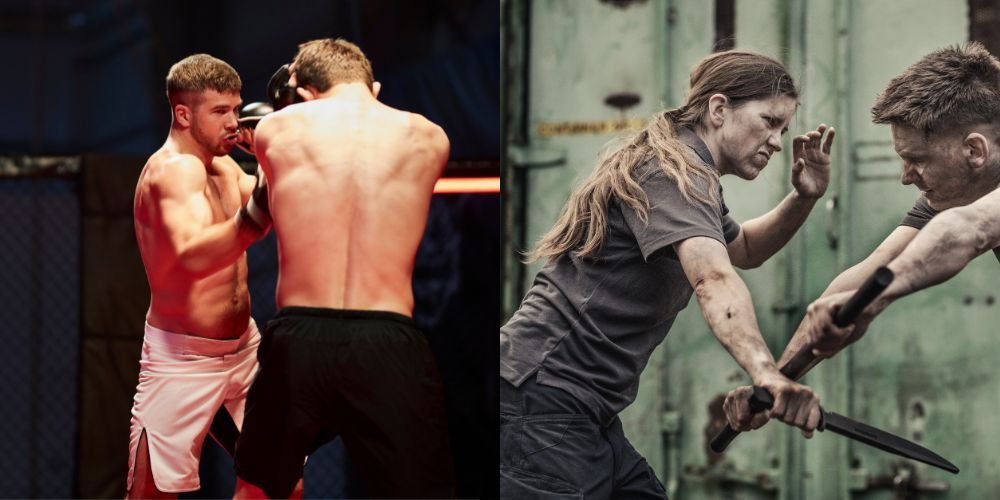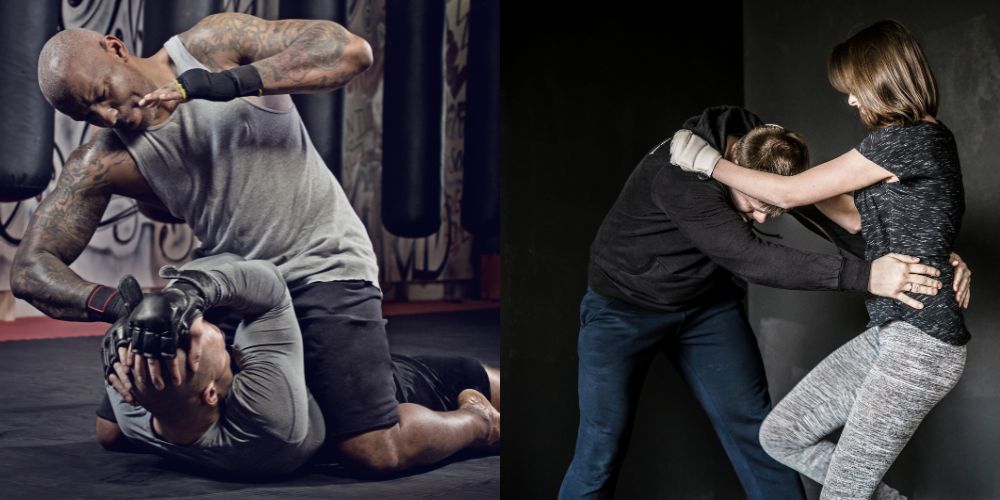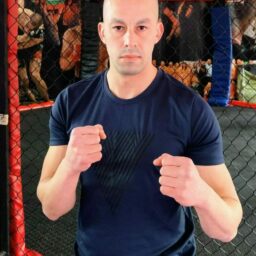Despite where you live and how peaceful it is, having the skills and confidence to deal with a self-defense situation is something many desire. But there are many ways and methods to acquire those abilities, and many usually compete for your time and money. Mixed martial arts and Krav Maga are two of the more popular choices, but how do they stack up to each other regarding self-defense effectiveness?
Krav Maga is a complete self-defense system with solid principles but often fails practically because there is no live resistance training. Using striking, grappling, and weapons teaches you to react in different real-life scenarios.
MMA, on the other hand, is a sport with rules and regulations, but the way of training makes every skill learned practical and applicable against an aggressive opponent.
The variety of methods, schools, and techniques in Krav Maga makes it challenging to summarize and compare to other styles. Nevertheless, this article will cover the most important features of MMA and Krav Maga and how they compare.
What Is MMA?
Mixed Martial Arts is a combat sport with a specific ruleset that allows for striking, grappling, and fighting on the ground. One of the key characteristics of MMA is the cage in which most fights are held.
The roots of modern MMA and mixed rules fights can be traced to different places and times throughout the 20th century, but the most significant event that sprung the quick rise of the sport to what it is today was the first UFC event in 1993.
MMA started as very limited rules-free fighting. Still, in just a decade, it became a regulated athletic discipline governed by Athletic commissions, which helped immensely in popularizing it mainstream.
Today MMA is arguably the largest combat sport comparable only to boxing. What began as simple style vs. style contests quickly evolved into a distinct discipline inspired and heavily influenced by dozens of martial arts but with techniques, tactics, and elements unique to MMA.

How to Dominate Every Fight with Raw, Explosive Power No One Can Match
Discover the underground blueprint that has quietly turned MMA hopefuls into legends, using nothing but sheer, brute force and bulletproof conditioning techniques.
What Is Krav Maga?
Krav Maga is a self-defense system designed to dispatch attackers quickly and efficiently. It uses techniques from many different fighting styles, including a significant element of fighting with and against contemporary weapons.
Krav Maga was developed by Imi Lichtenfeld on the streets of Bratislava, Slovakia, to help defend Jewish neighborhoods from fascists in Central Europe. Lichtenfeld began organizing fighter bands in Jewish neighborhoods in the run-up to World War II.
He taught them what he knew would be most effective based on his years of experience in boxing, wrestling, and surviving.
After Israel’s founding in 1948, Imi became the chief instructor at the Israeli Defense Force School of Combat Fitness.
His Krav Maga fighting system was taught to Israel’s most elite military forces there, and the initial intention of it was to be used only by military personnel. But gradually, the system reached civilians and was modified to their needs.
Today, there is a tremendous amount of training methodologies, all using the umbrella term Krav Maga more for marketing purposes than anything else.
Key Differences Between MMA and Krav Maga

Training
The big obstacle when making general conclusions about Krav Maga is that it’s not a single uniform system. There are wildly different academies with drastically different approaches to training and techniques used.
Some schools drill with some resistance and spar; others do not. Some focus more on unarmed combat, others on gun and knife defense and disarms. Some practice realistic scenarios that could happen in real life, while others do it more like combat sports training.
The instructor is also critical in Krav Maga. If the guy has done extensive Aikido before transitioning into Krav Maga, then the training and techniques will feature a lot of Aikido nonsense.
If he is a former boxer, chances are his approach will be more realistic and with more punches involved.
With this in mind, know that the following comparisons represent most of Krav Maga as general principles and how it’s trained on a larger scale.
Purpose
The purposes of the two styles we are comparing are what leads to most other differences. Krav Maga is a self-defense-only system with no competitive element.
This leads to a few key things the style aims to prepare you for which are different than MMA:
- Fighting with no rules means there are no restrictions on techniques or targets
- Dealing with an attacker as quickly and as ruthlessly as possible
- Fighting in an unpredictable environment
- A fight can happen anytime, anyplace, meaning you won’t have time to prepare physically or mentally
- Training with and against weapons
- There may be multiple attackers
On the other hand, MMA is a combat sport with tight rules and regulations. Here is how some of the same elements in Krav Maga stack up:
- There are rules and referees, and there are banned techniques both standing and on the feet
- MMA fights span multiple rounds, so strategies are used, and energy must be conserved
- Fights always happen in a cage or ring, which is safe
- You know when you are going to fight and have the time to warm up physically and mentally
Techniques
The biggest similarity between Krav Maga and MMA is that both borrow techniques from other styles and pick up what has been proven efficient (at least in principle).
Both use the standard punching set with straight, hook, and uppercuts; both have elbows, knees, kicks, throws, and joint locks.
But Krav Maga is even more versatile because things like headbutts, eye gouging, groin strikes, and every imaginable “dirty” tactic are not only not forbidden but encouraged because they target vulnerable areas and can end the fight quicker, which is the main goal in Krav Maga.
In addition, Krav Maga deals with contemporary weapons like guns, knives, and bats. Knife and gun disarms are key components of every respectable gym’s curriculum.
MMA has a lot more to offer on the ground, where wrestling, BJJ, and judo techniques are important.
Krav Maga also has a ground element, but getting on the floor is considered too dangerous and not encouraged, so it receives much less focus than in MMA.
Equipment
MMA and Krav Maga feature a lot of striking, which means you will need a lot of protective equipment. The good news is that much of the gear is the same for both styles, so if you train in one and want to try the other, you will already have most of what you need.
Here is what you will need for MMA training:
- Mouthguard
- Groin Guard
- MMA gloves
- Boxing gloves (for striking sparring)
- MMA shin guards
- Rash guard or other athletic shirts
- Fight shorts
For most Krav Maga gyms, you will need the same things as well since a lot of training is similar. The piece which is different between the two is the head guard.
In MMA, usually, it’s up to you if you want to use a head guard. But in Krav Maga, especially in gyms with situational sparring, having a good helmet with a face shield or grill is a must.
Krav Maga also deals with weapons, and you may need to have some training knives and guns and other protective equipment like knee pads, forearm guards, and body protectors.
More often than not, the gym will provide the weapons and other specific equipment needed.
MMA vs. Krav Maga For Self-Defense

The only important comparison between the two styles is their self-defense application and effectiveness.
It’s tough to determine how good Krav Maga is just because of the wide variety of training approaches. On paper and based on principles, Krav Maga should be the best self-defense system in the world, but what’s the reality?
This may anger many dedicated Krav Maga practitioners, but there is a simple question: is there live training under pressure against a resisting opponent?
If there is, the Krav Maga you are training will likely help you in self-defense. If there isn’t, then it’s just a bunch of nonsense.
It has been proven, without any doubt, that without real pressure training, no martial art works, and Krav Maga makes no exception.
Learning how to strike will give you an edge over a completely untrained opponent and build muscle memory and some reflexes in your body. But this won’t help you much in an actual violent situation.
Judging by the enormous amount of online content I’ve watched for this article and my real-life experience with guys training in similar self-defense systems, finding a good school is difficult, and most guys can’t really fight.
However, some schools are doing some very cool realistic training, even incorporating realistic environments and unpredictable moments of attack.
This is an excellent training methodology, and I would love to try it and be prepared for scenarios I will never encounter during MMA training.
I’ve also seen a lot of comments from people saying their instructor has a background in boxing, kickboxing, or MMA and teaches a more aggressive and real-life version of those and how to apply real techniques and principles in a self-defense situation.
Again, those are solid ideas and great for people who already have some skills and want to learn how to make them more applicable.
But sadly, the majority of Krav Maga schools do not do those things, and they won’t teach you how to fight for real.
The one thing they do better than training MMA is weapons training, but to be honest, if the attacker is armed with a knife or a gun, the chances of you winning are incredibly slim, regardless of how much training you have.
A real altercation will be unarmed for most people, and even a mediocre MMA skillset will give you a massive advantage over untrained guys and Krav Maga practitioners.
Here is a good video and analysis on the realities of Krav Maga with a wealth of video footage:
Krav Maga or MMA Which is Better?
Krav Maga was designed to be used by military personnel for hand-to-hand combat. In these situations, recruits have limited training and must be taught basic principles and techniques.
The fast and aggressive mindset taught in Krav Maga is excellent for soldiers, which was the system’s initial purpose. It teaches striking with a weapon and boosting aggressiveness, which undoubtedly works.
But for civilian unarmed hand-to-hand combat, MMA is vastly superior because it’s constant pressure tested both in the gym and in competition.
Regardless of whether there are rules, a punch, kick, and choke all feel the same. An MMA practitioner has thrown and received them countless times from resisting opponents, which is the only way to build the physical and mental resilience necessary for real under-pressure situations.
To finalize, join an MMA gym if you want to learn how to fight unarmed. If you want to learn real self-defense skills that work, you will have to find a Krav Maga school with sparring and realistic scenario training under pressure.
If you do, then go for it. Otherwise, you are just wasting your time.
My best advice is to train in MMA to learn how to fight and find a Krav Maga gym that does situational sparring with unexpected elements and test and hone your skills, reaction, and awareness here. This way, you will take the best of both worlds.

